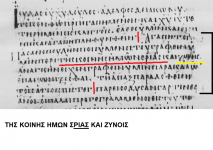Jude 1:3 (AV)
Beloved, when I gave all diligence to write unto you of the common salvation,
it was needful for me to write unto you,
and exhort you that ye should earnestly contend for the faith
which was once delivered unto the saints.
The variant that interests us is "common salvation" where Sinaiticus has "common salvation and life" and both "and life" and "common salvation and life" are late variants (unless you presume Sinaiticus to be early.)
======================================
CSP
Codex Sinaiticus is one of the most important books in the world. Handwritten well over 1600 years ago, the manuscript contains the Christian Bible in Greek, including the oldest complete copy of the New Testament. The Codex Sinaiticus Project is an international collaboration to reunite the...
codexsinaiticus.org
LaParola
http://www.laparola.net/greco/index.php?rif1=72&rif2=1:3
σωτηρίας] p72 A B C K L P 049 056 0142 5 6 18 35 61 81 88 93 181 254 307 323 326 431 436 442 453 468 621 623 630 665 808 909 915 1067 1243 1409 1501 1678 1739 1836 1837 1845 1875 1881 2200 2298 2344
vid 2374 2805 Byz l596 ς WH
ζωῆς] 1505 1611 syr eth
σωτηρίας καὶ ζωῆς] א Ψ
Na text
Ἀγαπητοί, πᾶσαν σπουδὴν ποιούμενος γράφειν ὑμῖν περὶ τῆς κοινῆς ἡμῶν σωτηρίας ἀνάγκην ἔσχον γράψαι ὑμῖν παρακαλῶν ἐπαγωνίζεσθαιτῇ ἅπαξ παραδοθείσῃ τοῖς ἁγίοις πίστει.
======================================
Facebook - 2014
Jude 1:3
https://www.facebook.com/groups/sinaiticus/permalink/324566504386828/
One of the issues that comes up with Codex Sinaiticus, if it is of 19th century vintage, is:
"where did the text come from".
Since Sinaiticus has textual affinities with Alexandrian mss, including Vaticanus, if it was written in the 1800s, there would have had to have significant input from the minority Alexandrian mss line. And we noted that other Alexandrinan mss have a Mt. Athos heritage (ms. Codex Colbertinus 2844 == ms 33 may have been one that came up in the Pinto-White post-debate discussions, when James Snapp mentioned that certain variants highlighted had agreement wider than Vaticanus and papyri. Maybe Ψ was mentioned, see below. ) This earlier discussion is from memory, also Simonides referenced Alexandrinus, which is also very Alexandrian outside the Gospels. I'll try to check the notes on these notes about possible Alexandrian sources for a Simonides text later.
We found that some questions on this source ms point were interesting (e.g. Scrivener raised it as a primary consideration) while others were totally bogus (the thousands of variants in the papyri only claim of James White).
Since so many Sinaiticus variants are omission and chopped-off text and singular blunders, variants that would indicate a later origin would be the exception. (Since omissions and blunders are trivially easy to occur.)
Today I want to look at one that is supposed to be a very unlikely and puzzling conflation, in Sinaiticus, where one of the texts that was supposedly conflated into the Sinaiticus combined reading has no early support!
.
Jude 1:3
Beloved, when I gave all diligence to write unto you of the common salvation,
it was needful for me to write unto you,
and exhort you that ye should earnestly contend
for the faith which was once delivered unto the saints.
Sinaiticus has "common salvation and life". This is an unusual conflation of mss that have either "common salvation" or "common life" .
And, putting aside Sinaiticus, any variant with "life" is late.
The "common salvation and life" variant is seen earliest in Greek in Codex Ψ (psi - also 044) - a late uncial ms from the 9th-10th century. Source of the ms. - Mt. Athos. ... hmmm
Also note that "life" is attested by the later Syriac mss, principally the Harklean (possibly the Philoxenian). And late Greek minuscules. And that the theory of a later Sinaiticus works with both Mt. Athos mss and Syriac mss (per Simonides).
Here is Ψ - 044.
Codex Athous Lavrensis
https://en.wikipedia.org/wiki/Codex_Athous_Lavrensis
.
Now, this was not found by a search of the ms. And some apparatuses (e.g. LaParola) do not even have the variant. There is a recent discussion on the NT Textual Criticism forum, that shows the variants, and an earlier post on:
.
================================
[textualcriticism] How Old Is the Harklensis Group's Text?
James Snapp - May 29, 2014
(no longer online)
Tommy Wasserman Jude p. 247
"Codex Sinaiticus' text of Jude verse 3 reads, KOINHS HMWN SWTHRIAS KAI ZWHS. ("Our common salvation and life.") Wasserman commented about this: "A few witnesses, including the nucleus HK group, replace SWTHRIAS with ZWHS (1505 1611 2138 S:HPh), whereas
a few important MSS attest a conflation, THS KOINHS HMWN SWTHRIAS KAI ZWHS (01 044 2627Z). The attestation of ZWHS by 01 shows that the substitution is early."
[textualcriticism] Jude v. 3: Old MS w/Young Reading; Young MSS w/Old Reading
James Snapp - March 28, 2013
"an excellent example of a conflation in a flagship Alexandrian manuscript (Sinaiticus)"
James Snapp
"However, there is no evidence that "and life" even existed as a variant until long after Sinaiticus."
"This raises a question: should all of the readings shared by 3-out-of-4 of these four manuscripts in the General Epistles be considered older than Codex Sinaiticus?"
Daniel Buck
> I'd certainly be willing to entertain that thought.
Steven
Definitely, and I entertain this as well. And for the simple and special reason that this is additional evidence that Codex Sinaiticus is not a fourth century ms.
How could it conflate a reading that becomes a variant "long after Sinaiticus?" And the idea that this was an orphan addition that was then repeated by an unrelated scribe centuries later, while surely possible, is exceedingly difficult and unlikely.
.
================================
Text and Translation Note on Jude 1:3
Jeff Riddle
http://www.jeffriddle.net/2011/05/textual-and-translation-note-on-jude-13.html
Two other codices (1505 and 2495) read humon zoes, also making it a second person plural pronoun and changing the noun, so “your common life.”
Then, most interestingly, Codex Sinaiticus (along with codex Psi) provides the harmonizing reading, hemon soterias kai zoes, so “our common salvation and life.”
This variation is noteworthy on several levels. First, it demonstrates again that codices Sinaiticus and Vaticanus, though often presented as putting forward a unified alternative to the traditional text, are very often, in fact, at odds with one another. Second, this example shows that Sinaiticus can bear a tendency to harmonize and conflate variant readings. This undermines its reliability as a clear witness to the “original text.”
================================
Note this Sinaiticus variant is discussed in commentaries by Lewis R. Donelson, 2010 and Philip W. Comfort, 2008.
https://www.facebook.com/groups/267050166805129/user/100000786212850/
================================
Lewis R. Donelson
http://books.google.com/books?id=FWACViVPKCMC&pg=PA173
======================================
Facebook - New Testament Textual Criticism - 2014
https://www.facebook.com/groups/NTTextualCriticism/permalink/690340371052966/
James Snapp
For example: consider the following six rival readings in Jude, verse 3.
(1) peri ths koinhs hmwn swthrias
(2) peri ths koinhs swthrias
(3) peri ths koinhs umwn swthrias
(4) peri ths koinhs hmwn zwhs
(5) peri ths koinhs umwn zwhs
(6) peri ths koihnhs hmwn swthrias kai zwhs
that is, in English:
(1) concerning our common salvation
(2) concerning the common salvation
(3) concerming your common salvation
(4) concerning our common life
(5) concerning your common life
(6) concerning our common salvation and life (is this a GSR construct)
Which reading seems to you to be original? Which reading seems most likely to be dependent upon at least one of the others? (And please try to present your impressions from the *internal* evidence; no fair consulting a GNT to see what witnesses support which variants.)
======================================
====================
Vaticanus is the later cursive hand.
====================




